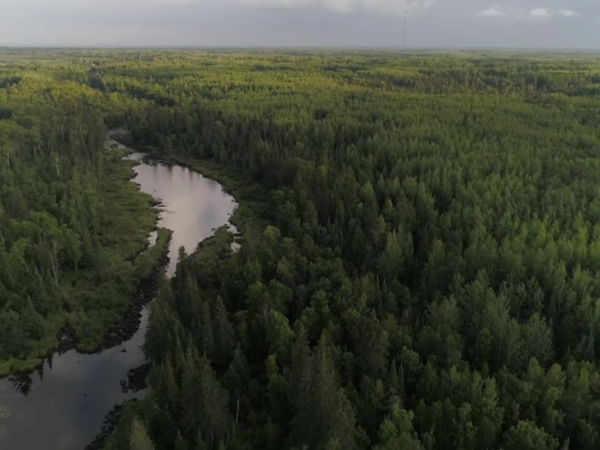
Great Lakes Moment is a monthly column written by Great Lakes Now Contributor John Hartig. Publishing the author’s views and assertions does not represent endorsement by Great Lakes Now or Detroit Public Television.
Lake whitefish is an important commercial fishery in Lake Erie and is culturally and economically important to local First Nations. It is also an important food source for other fishes and an important indicator of ecosystem health. Although Lake Erie’s population has declined in recent years due to poor survival during their first year of life, fishery biologists have shown that the Detroit River is an important source for young lake whitefish. These young Detroit River whitefish add resilience to Lake Erie stocks, despite suffering from severe human-caused disturbances.
History of Detroit River Lake Whitefish
Historically, Detroit River was well known for its exceptional fishery. For example, in 1872 Detroit ranked second only to Chicago in harvesting more than 3.4 million pounds of fresh fish, mostly lake whitefish and cisco (formerly known as lake herring). These fisheries used netted ponds in the Detroit River to keep fish alive from fall to late winter when they were taken out and sold in the Detroit markets.
The best ponds were located off islands in the middle of the river where there was ample circulation to keep fish alive and in healthy condition. These ponds were enclosures in the river made by driving piles close together and then stringing the nets to the piles. A crew of 30 men were employed at Detroit River’s Grassy Island fishery. Each pond would hold 25,000-40,000 whitefish. Harvest in the Detroit River exceeded more than 500,000 pounds in the late 1800s and declined through the early part of the 20th century. Overharvest and habitat degradation resulted in very low catches after about 1910.

Grassy Island pond-fishery in the Detroit River, 1874 (credit: U.S. Commission of Fish and Fisheries).
Probably the most dramatic spawning habitat destruction was the construction of the shipping channels in the Detroit River. Millions of tons of limestone bedrock, cobble, and gravel were removed from the lower Detroit River to create the Livingstone and Amherstburg shipping channels to support commerce. These rock and gravel substrates provided critical spawning habitats for rock-loving spawning fishes like lake whitefish, lake sturgeon, walleye, and others.
Shipping channel construction began in 1874 and continued through the early 1900s. The construction of the nearly 12-mile Livingstone Channel — 22 feet deep and nearly 300 feet wide — was particularly damaging, greatly altering the river’s hydrology and destroying many rocky shoals and rapids critical fish spawning grounds. Spawning runs of lake whitefish into the Detroit River almost disappeared by the early 1900s due to overfishing, degradation of habitat, and phosphorus-induced enrichment called eutrophication.
Lake Erie Lake Whitefish Fishery
Lake whitefish is considered a cold-water fish and spends much of its adult life in the colder and deeper eastern basin of Lake Erie. There was a whitefish fishery in the eastern basin until a population crashed in the 1960s. The cause of the population crash was overexploitation, predation by and competition with invasive species, degraded water quality and habitat, and loss of small shrimp-like invertebrates called Diporeia — an important food source.
After an absence of about 20 years, whitefish commercial fishing in Lake Erie increased to over one million pounds per year during the late 1990s and early 2000s. Harvest over the last decade has been low compared to previous decades, with only 170,000 pounds caught in 2022 — nearly 70% in Ontario and about 30% in Ohio. This provides evidence that a large proportion of young lake whitefish are dying before being large enough for harvest.
“Lake Erie’s lake whitefish population has declined in recent years due to poor survival during the first growing season,” noted Dr. Robin DeBruyne, fish biologist with the U.S. Geological Survey’s Great Lakes Science Center. “Our current research efforts are focused on understanding why this is occurring and how to unlock the recruitment bottleneck limiting the number of young lake whitefish surviving to larger sizes where they can be caught by fishers and eventually spawn to replenish the population.”
Whitefish Spawning in the Detroit River
During the 1960s and 1970s, the Detroit River was considered one of the most polluted rivers in the United States and this pollution had a substantial negative impact on fish and other species living in the river. Since then, substantial water quality improvements have occurred in response to controlling pollutant inputs from industries and municipal wastewater treatment plants under the U.S. Clean Water Act and the U.S.-Canada Great Lakes Water Quality Agreement.
Based on research and monitoring, fishery biologists and managers concluded that reproduction of lake whitefish, lake sturgeon, and other rock-loving spawners in the 2000s was likely more limited by habitat than environmental quality. Then in 2006, lake whitefish spawning was documented in the Detroit River for the first time since 1916 further strengthening the hypothesis that if you build whitefish habitat in the river, they will come. In response, ten fish spawning reefs made of limestone rock were constructed in the Detroit River over the last 20 years.
The most recent estimates of total annual export of larval lake whitefish from the Detroit River to western Lake Erie ranged from 29 million in 2010 to 84 million in 2011. Given the widespread whitefish spawning in the Detroit River, large numbers of larvae produced and entering western Lake Erie, and continued system-wide water quality and aquatic habitat improvements, the Detroit River provides valuable habitat with added resilience — the capacity to respond to disturbance or perturbation by resisting damage and subsequently recovering — to Lake Erie fisheries.

Larval lake whitefish collected from the Detroit River (credit: U.S. Geological Survey).
“These tens of millions of larval lake whitefish entering Lake Erie from the Detroit River are important,” said Dr. DeBruyne. “When you’re dealing with a depressed whitefish population, like in Lake Erie, every source is important in trying to reach our goal of achieving a self-sustaining population that can support a viable fishery.”
Upon entering Lake Erie from the Detroit River, whitefish larvae flow with the currents through the western and central basins of Lake Erie to their ultimate destination of the eastern basin. Along their journey, they are subjected to many human-caused disturbances like harmful algal blooms, invasive species, and poor water quality from agricultural and urban runoff. Research scientists are continuing to work with resource managers, First Nations, and other stakeholders to understand why so few young lake whitefish are surviving to adults. Through this collaboration they hope to co-produce the necessary knowledge and co-innovate solutions necessary to achieve their common vision of healthy fish communities, with sustainable commercial and recreational fisheries.
John Hartig is a board member at the Detroit Riverfront Conservancy. He serves as a Visiting Scholar at the University of Windsor’s Great Lakes Institute for Environmental Research and has written numerous books and publications on the environment and the Great Lakes. Hartig also helped create the Detroit River International Wildlife Refuge, where he worked for 14 years as the refuge manager.
Catch more news at Great Lakes Now:
Great Lakes Moment: Saving the Conservation Crescent
Great Lakes Moment: Gordie Howe International Bridge becomes part of binational trail system
Featured image: A lake whitefish captured in the Detroit River (credit: U.S. Fish and Wildlife Service).




